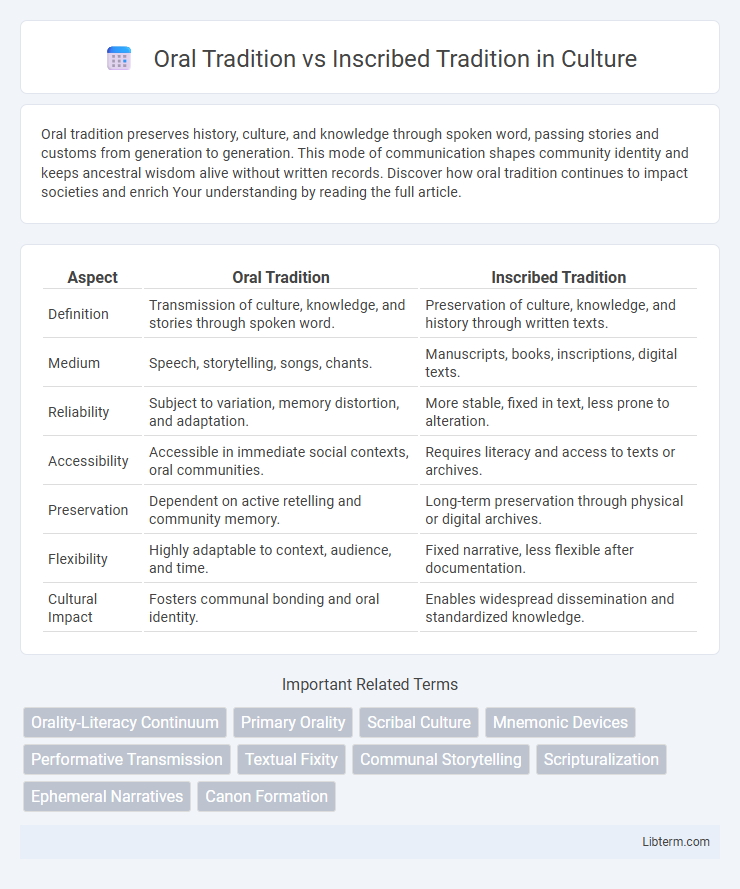Oral tradition preserves history, culture, and knowledge through spoken word, passing stories and customs from generation to generation. This mode of communication shapes community identity and keeps ancestral wisdom alive without written records. Discover how oral tradition continues to impact societies and enrich Your understanding by reading the full article.
Table of Comparison
| Aspect | Oral Tradition | Inscribed Tradition |
|---|---|---|
| Definition | Transmission of culture, knowledge, and stories through spoken word. | Preservation of culture, knowledge, and history through written texts. |
| Medium | Speech, storytelling, songs, chants. | Manuscripts, books, inscriptions, digital texts. |
| Reliability | Subject to variation, memory distortion, and adaptation. | More stable, fixed in text, less prone to alteration. |
| Accessibility | Accessible in immediate social contexts, oral communities. | Requires literacy and access to texts or archives. |
| Preservation | Dependent on active retelling and community memory. | Long-term preservation through physical or digital archives. |
| Flexibility | Highly adaptable to context, audience, and time. | Fixed narrative, less flexible after documentation. |
| Cultural Impact | Fosters communal bonding and oral identity. | Enables widespread dissemination and standardized knowledge. |
Defining Oral Tradition
Oral tradition refers to the transmission of cultural knowledge, stories, customs, and beliefs through spoken word across generations without written records. It relies on memory, performance, and communal participation to preserve historical narratives and societal values. This mode ensures adaptability and emphasizes the relational aspects of knowledge within communities, contrasting with the fixed nature of inscribed tradition.
Understanding Inscribed Tradition
Inscribed tradition refers to the preservation and transmission of knowledge through written texts, which ensures accuracy and longevity across generations. Unlike oral tradition, reliant on memory and performance, inscribed tradition provides a stable record that can be analyzed, referenced, and disseminated widely. The development of scripts and manuscripts in ancient civilizations such as Mesopotamia and Egypt marked critical milestones in establishing inscribed traditions.
Historical Origins of Both Traditions
Oral tradition originated as the earliest method for preserving and transmitting knowledge, stories, and cultural values through spoken word and memory across generations before written systems existed. Inscribed tradition began with the emergence of writing around 3200 BCE in Mesopotamia, enabling more permanent, accurate record-keeping and dissemination of historical events, laws, and religious texts. The historical origins of both traditions highlight a transition from fluid, communal memory systems to fixed, reproducible texts that transformed cultural preservation and communication.
Transmission Methods and Memory
Oral tradition relies on the spoken word, using stories, songs, and rituals passed down verbally across generations, emphasizing memory, repetition, and communal participation to preserve cultural knowledge. In contrast, inscribed tradition employs writing systems, such as manuscripts, inscriptions, and digital texts, to transmit information across time and space, ensuring accuracy and permanence independent of individual memory. The shift from oral to inscribed transmission transforms cultural retention by moving from adaptive, mnemonic-based communication to fixed, externally stored records.
Reliability and Preservation
Oral tradition relies on memory and communal participation, which can lead to variations and potential distortions over time, affecting reliability. Inscribed tradition, through written records, offers more precise preservation of information across generations, minimizing alterations. The durability of materials like stone or parchment further enhances the longevity and authenticity of inscribed records compared to the fluid nature of oral transmission.
Role in Shaping Culture and Identity
Oral tradition serves as a dynamic medium for transmitting cultural values, myths, and histories through generations, fostering a collective identity rooted in communal memory and performance. Inscribed tradition, through written records and texts, preserves knowledge with greater permanence and enables the codification of cultural norms, laws, and religious beliefs that shape societal structures. Together, these traditions complement each other in defining cultural identity, with oral tradition emphasizing fluidity and communal participation, while inscribed tradition ensures durability and formalization of cultural heritage.
Adaptability and Change Over Time
Oral tradition demonstrates high adaptability, evolving through generations as stories and knowledge are reshaped by cultural context and memory, allowing for variations and reinterpretations. Inscribed tradition, anchored in fixed texts like manuscripts or inscriptions, offers stability but less flexibility for spontaneous change, preserving information with greater consistency over time. The dynamic nature of oral tradition supports cultural adaptability, while inscribed tradition provides a dependable record essential for historical accuracy and continuity.
Influence on Literature and Storytelling
Oral tradition shapes literature and storytelling through dynamic, adaptable narratives passed verbally across generations, emphasizing communal memory and cultural identity. Inscribed tradition influences literature by preserving fixed texts, enabling complex narratives and authoritative reference, thus facilitating widespread dissemination and historical continuity. The interplay between oral fluidity and inscribed permanence enriches literary evolution and storytelling techniques globally.
Challenges in Modern Contexts
Oral tradition faces challenges in modern contexts due to the risk of information loss and distortion as it relies heavily on memory and verbal transmission without physical records. Inscribed tradition, while more durable through written documentation, encounters obstacles such as limited accessibility for non-literate populations and digital obsolescence threatening long-term preservation. Both traditions struggle to adapt to rapidly evolving communication technologies and global cultural shifts, necessitating innovative methods to safeguard and transmit cultural knowledge effectively.
Future of Tradition in the Digital Age
Oral tradition, rooted in communal memory and storytelling, faces transformation as digital platforms enable wider preservation and dissemination, blending vocal narratives with multimedia archives. Inscribed tradition, characterized by written and recorded texts, evolves through digitization, enhancing accessibility and interactive engagement with cultural heritage. The future of tradition in the digital age hinges on integrating oral and inscribed forms via technologies like AI, digital repositories, and social media to sustain and expand cultural transmission.
Oral Tradition Infographic

 libterm.com
libterm.com